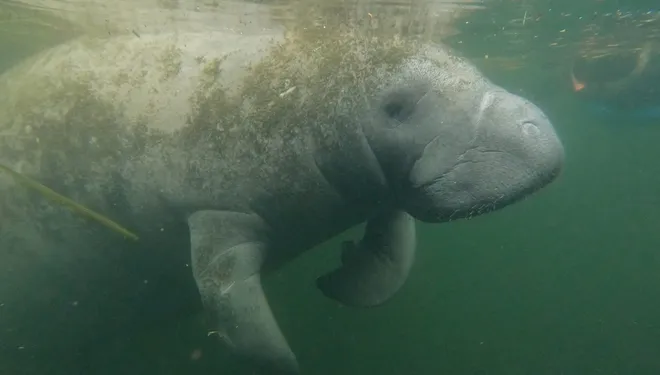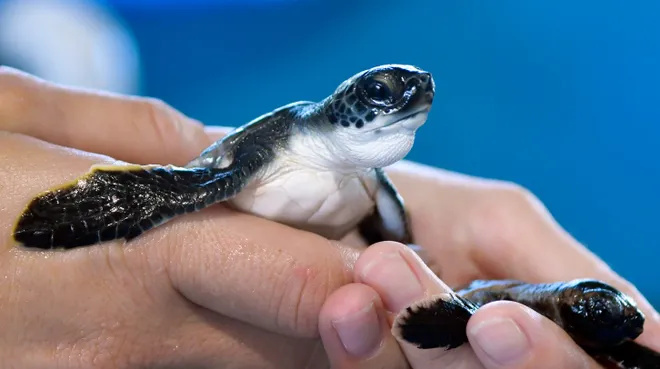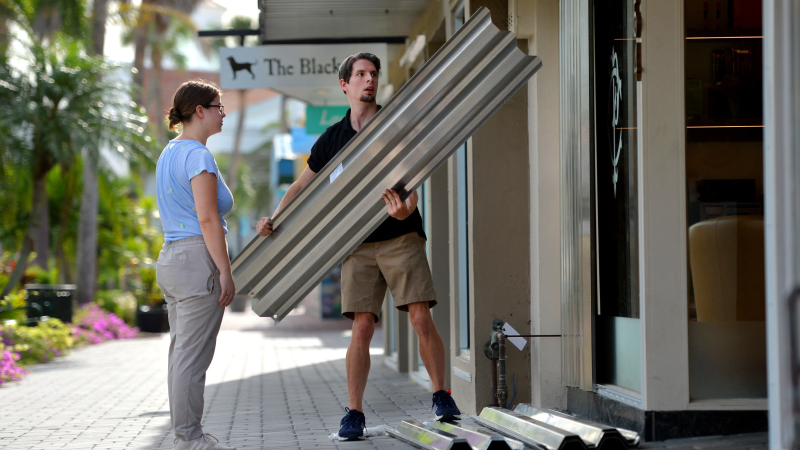As Hurricane Helene approaches, what happens to the manatees?
As Florida's Gulf Coast readies for Hurricane Helene to make landfall as a major hurricane Thursday, it's not just human residents who are at risk. Florida's wildlife will be bracing for impacts to their habitats and weathering the storm, too.
Large sea creatures like sharks and whales are able to quickly move to calmer waters when a rough storm like Helene passes through, and are generally not affected by hurricanes, according to the National Ocean Service. But other animals may be stranded, displaced or killed in large numbers.
"Any hurricane will affect organisms in the same way that it affects humans: Some will be affected more than others," said Deby Cassill, an integrative biologist at the University of South Florida.
Last year, flamingos from as far as the Yucatan Peninsula in Mexico were spotted across Florida and even in Wisconsin, Missouri and Kansas after Hurricane Idalia. Manatees were left stranded after Hurricane Irma in 2017.
LIVE STORM UPDATES:Helene reaches hurricane status ahead of landfall in Florida
Hurricanes can generate massive waves, mixing warmer surface water with cooler and saltier water below. Reduced salt levels brought on by heavy rain or shifting sands in shallow waters blocking sunlight can damage coral and other life. Out of the water, experts say rain and winds impact birds, tortoises, and many other species. But for the most part, Cassill said, Florida's wildlife can adjust to weather challenges.
The zoo in Tampa is also preparing to close Thursday and transferring its large animals to their night houses, which it says are built to withstand bad weather. Smaller animals and birds are also being brought indoors to ride out the storm, ZooTampa said in a statement. An "animal care storm-ride-out team" will be at the zoo overnight.
How do animals survive a big storm?
For some animals, a hurricane can even be "exciting," Cassill said. Whales and sharks, which are large and fast enough to swim away from real danger, run on similar brain chemicals as humans, such as dopamine and serotonin, Cassill said. Birds, too, may find a storm a stimulating challenge.
"A storm is great adventure for them," she said.
Fish can withstand being tossed around to an extent, too, Cassill said. Little marine worms called polychaete, a cousin of earthworms, have their own special way of surviving a hurricane. They build a tube about a meter down and just "bulldoze" down during a hurricane to stay safe.
And many birds caught in high winds can eventually find their way back because they are in tune with Earth's geomagnetic system, Cassill said.
Manatees might become stranded after hurricane
Manatees may become stranded or injured by debris during hurricanes. In years past, they have been discovered after hurricanes in a dry bay, in a golf course pond and a retention pond. Hurricanes can also destroy their primary food source of seagrass beds, according to the Fish and Wildlife Foundation of Florida, though Cassill said Helene is unlikely to be strong enough to do too much damage to their food.
If you see a stranded or trapped manatee or other animal such as a dolphin after a storm, it's best not to approach it or try to rescue it yourself, the Florida Fish and Wildlife Conservation Commission says. Instead, you can call its Wildlife Alert Hotline at 888-404-3922. A manatee may need medical attention after being stranded.
"The best way people can stay safe and help wildlife under storm conditions is to be alert and give wildlife their space," the commission says.

What happens to fish and turtles?
Most fish can withstand some rough water, Cassill said, and fish close to the coast that might see bigger waves have the ability to swim away from the turbulence.
The most common reason for fish to die after a storm is low oxygen levels in water caused by winds that push surface waters. Water from the bottom that is low in oxygen and may contain lethal hydrogen sulfide can rise up. Also, if there are long stretches of cloudy days amid a storm, oxygen-producing organisms and plants can't photosynthesize, according to the Florida Fish and Wildlife Conservation Commission.

Sea turtle nesting season also tends to overlap with Florida's hurricane season. The FWC says no storm season is a total loss for nesting sea turtles, because female turtles deposit nests throughout the season so that at least some nests will survive even if there is a storm. But hurricanes can cause higher tides, flooding the nests, or beach erosion, leaving nests to dry out or making them vulnerable to predators, according to Maia McGuire, a University of Florida marine biologist.
"After big storms, you may spot hatchlings tangled in seaweed on the shore or in places they don’t belong like pools or yards," the Florida Fish and Wildlife Conservation Commission says. Don't try to put them back in the ocean; call the Wildlife Alert Hotline. Turtles actively crawling toward the water don't need any help.
Land and air creatures might turn up in unexpected places
It's not just sea creatures that are impacted in a major tropical storm or hurricane. Residual effects of storms are felt by animals from snakes to bears on land, and you may see animals in unusual places after a storm.
Bears are attracted to spoiled food and trash while communities clean up from storms. The Florida Fish and Wildlife Conservation Commission advises keeping any food waste and debris separate and secured.

Burrowing owls might turn up in the eaves of your home after a storm, because high water levels from heavy rains can displace them from their burrows, and human activity during cleanup can bury them.
Flamingos ended up far from home after Idalia
In the aftermath of Idalia in 2023, flamingos turned up in areas of the U.S. where they'd never been seen before. In the weeks following the storm, at least 150 American flamingos were seen in more than four dozen locations across Florida and in at least 14 states.
The flamingos were swept up in the storm and deposited as far away as Wisconsin, Missouri and Kansas. Many were traced back to origins in the Yucatan Peninsula.
Some of the birds died, but others were seen starting to move back southward and forming groups, experts told USA TODAY at the time. Read more.
Contributing: Dinah Voyles Pulver, USA TODAY; The Fort Myers News-Press
Disclaimer: The copyright of this article belongs to the original author. Reposting this article is solely for the purpose of information dissemination and does not constitute any investment advice. If there is any infringement, please contact us immediately. We will make corrections or deletions as necessary. Thank you.






